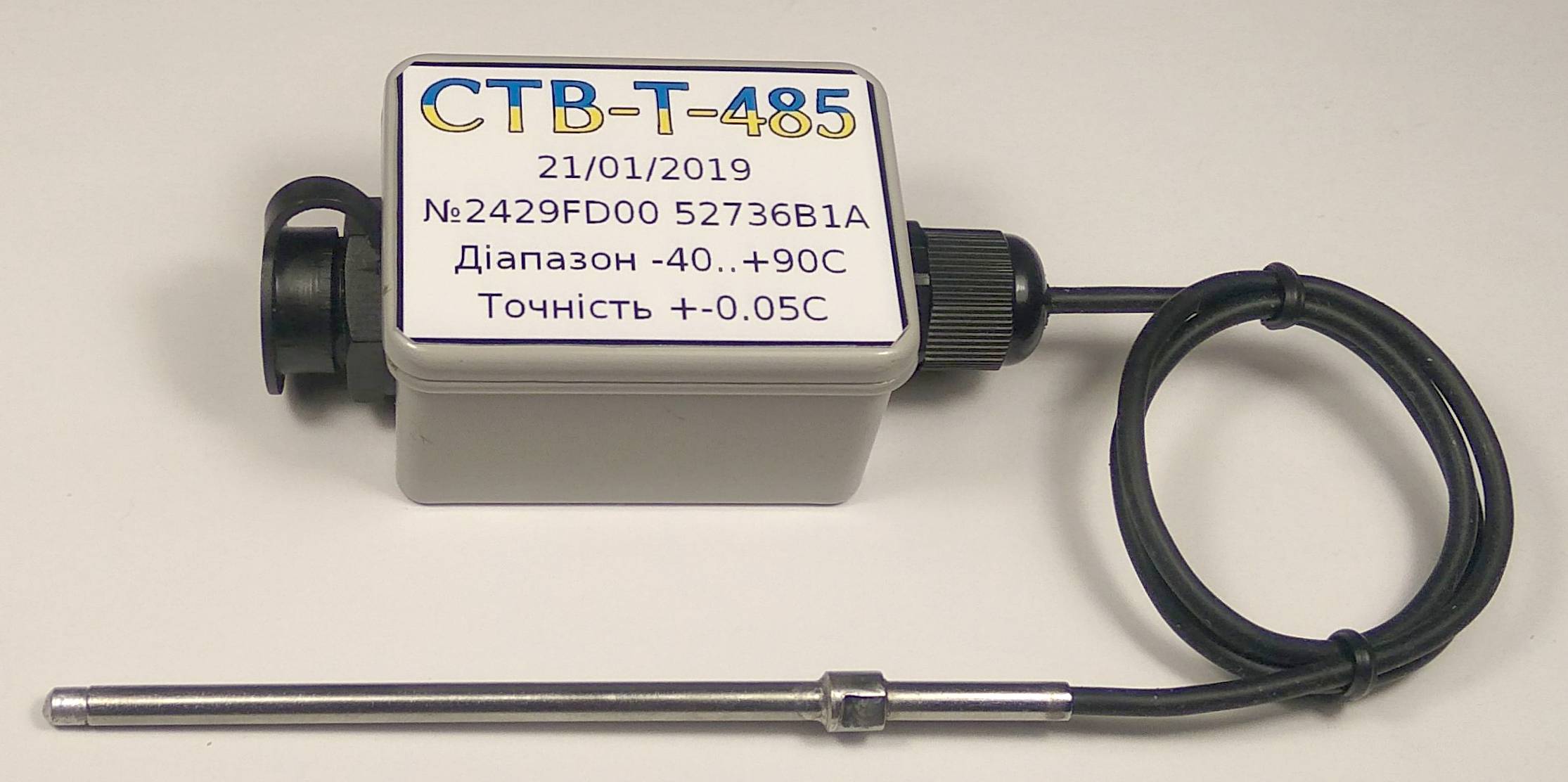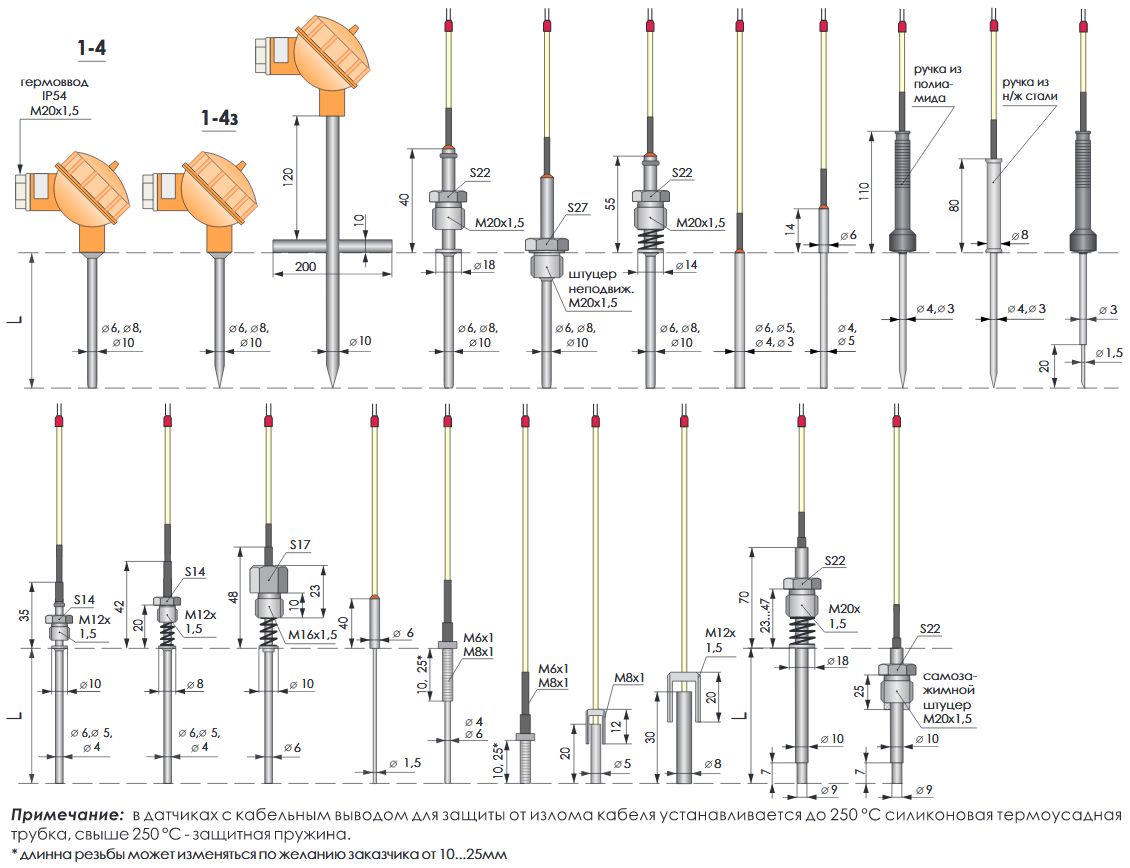
High-precision micro-power digital temperature sensor (temperature-code converter) with RS-485 interface

Main characteristics
Primary converter |
platinum resistance thermometer Pt1000 |
Measurement range |
-40..+90 °C; -40..+180 °C; |
Accuracy over the entire measurement range |
< ±0,1; ±0,05;±0,02; ±0,01 °C |
Thermal inertia index |
< 20 sec |
Wiring diagram |
4-wire connection with shielded signal cable (2-wire RS-485 line plus common ground wire connected to the shield and power wire) |
Calibration standard |
ITS-90 |
Supply voltage |
2.7..5.5 V |
Maximum pulse current consumption in active mode |
< 1.5 mA |
Standby consumption current |
< 4 uA |
Average current consumption in the continious reading with a period of 30 sec |
< 12 uA |
Average current consumption in standby mode with continuous polling of other RS‑485 nodes |
< 25 uA |
Active mode consumption current (if you have an isolated RS-485) |
< 2 mA |
Standby consumption current (with isolated RS-485) |
< 500 uA |
Current consumption (with active device heating) |
< 120 mA |
Ambient temperature |
-40..+70 °C |
Start time after power up |
< 100 msec |
Measurement speed |
up to 10 SPS |
Material of protective reinforcement |
stainless steel |
Converter housing material |
aluminium alloy |
Immunity to dust and moisture |
IP-65, IP-67 |
Length of communication line |
< 1500m (9600bps speed) |
Data transfer rate (with an increase in speed of more than 9600bps (up to 3Mbps), the converter goes out of micro-power mode) |
9600, 4800, 2400, 1200, 600bps |
The number of devices on the RS-485 bus |
up to 247 |
High-precision measuring device designed for remote automatic data collection using a standard communication protocol without special software.
Power supply of the device is negligible and is carried out directly from the RS-485 bus. With a maximum network load (continuous serial polling of 247 devices), the total consumption in the RS-485 power supply circuit does not exceed 7 mA (for non-isolated RS-485 interface).
Isolated or non-isolated RS-485 interface. Communication protocol Modbus RTU (optionally it is possible to connect using other protocols based on the RS-485 interface). Up to 247 sensors in the network.
High noise immunity.
High reliability and long-term stability.
Designed for mass production.
Design features
STV-T-485 consists of a primary sensor - (Pt1000) in a cylindrical protective casing made of stainless steel of the required length and a processing and conversion unit, placed in a sealed aluminum alloy case with dimensions of 35x40x50mm and equipped with an 8-pin POLSUN connector, connected by a 300mm heat-resistant silicone cable.
Possible versions of the thermometer: sleeve, sleeveless, to the surface.

In case of a sleeveless design, the required length of the primary sensor is selected from the range: 25, 32, 50, 80 mm.
When the sleeve version is from a number: 32, 50, 80, 120, 160, 200, 250, 300, 440, 530mm.
Interface and system integration features
The device combines a sensor (sensing element) and a transducer, which processes the readings from the sensor and transmits them via the RS-485 interface.
A platinum resistance thermocouple is used as the primary temperature sensor in the probe. The on-demand electronic unit converts the thermal resistance parameter into digital code packets in the standard EIA/TIA RS-485. This makes it possible to build distributed control systems and process control systems without the use of additional converters using the standard network digital exchange protocol ModBUS RTU (www.modbus.org). The electronic unit includes an ADC and a microcontroller, in which an algorithm for converting electrical resistance into a digital code is programmed. This algorithm includes a procedure for calibrating a platinum resistance thermometer according to ITS-90, correction of thermometer readings based on calibration results, as well as additional service functions.
At the request of the network master (register reading procedure), the results of temperature measurements are given.
With one master device (PC or PLC) and one communication line, it is possible to take readings from many sensors in the network (up to 247), by sequential polling.
Areas of use
Machine building and metalworking
Power engineering
Production of technological equipment by industry
cold production (refrigeration and air conditioning)
heat production (heat engines and air conditioning)
heating networks
heat exchange equipment
Construction and municipal engineering
Agricultural engineering
Oil and gas engineering
oil / gas heaters
equipment for oil refining
gas and oil transportation equipment
Chemical engineering
Timber industrial engineering
Automotive industry
Machine tool
Food industry equipment
Industry of household appliances and machines
Instrumentation
heat and water meters
gas meters and gas volume correctors
Radio and electronics industry
Electrical industry
Chemical and petrochemical industry
petrochemistry
agrochemistry
polymers and elastomers
pharmaceutical chemistry
perfumes and cosmetics
Fuel industry
gas industry
oil industry
Pulp and paper industry
Building materials industry
Food industry
soft drinks industry
wine industry
confectionery industry
canning industry
pasta industry
oil and fat industry
dairy industry
milling industry
meat industry
brewing industry
fruit and vegetable industry
poultry industry
fish industry
sugar industry
alcohol industry
tobacco industry
Medical industry